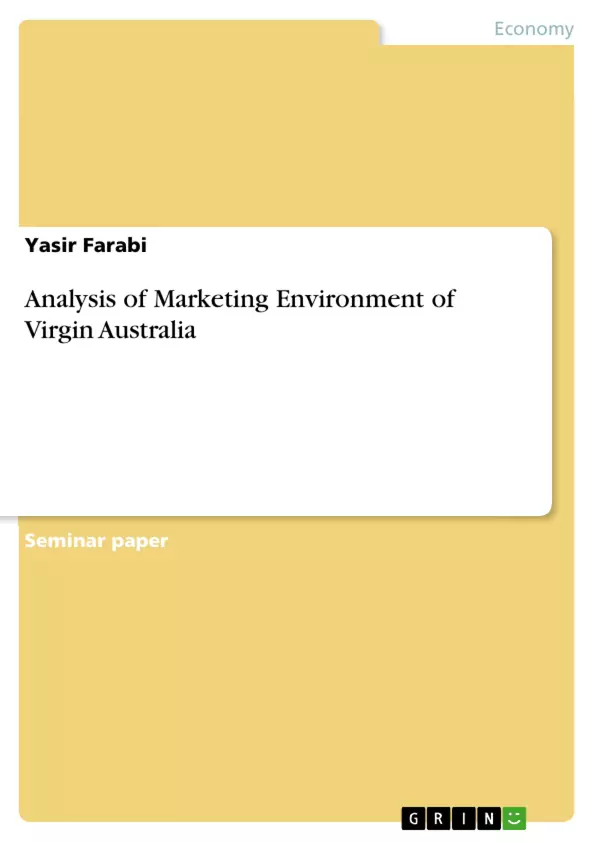The purpose of this report is to analyse the current market environment of Australian airline industry in which Virgin Australia operates.
Throughout the last decade, the domestic airline industry in Australia is characterised by relatively flat growth, low profit margins and financial pressure and stiff competition. High entry barrier exists in the industry with soaring competition among the existing players. Even though the threat of substitutes is low, the overall situation is further worsened by high buyer and supplier bargaining power.
Qantas, Jetstar and Tiger Airways are the three major players of the industry with Virgin Australia being the second largest domestic airline. While Qantas focuses its strategy towards high-end business class and corporate customers, Jetstar and Virgin compete for the rest of the market segments. Except Tiger Airways all three companies have shown positive financial performance over their operating cycles.
Virgin Australia has strong brand value and image because of its innovative ideas and creative thinking. It operates a rapidly growing fleet primarily consists of Boeings and Airbuses. The low average fleet age helps the company to reduce maintenance cost of the aircrafts. Financial performance of the company was not so promising in the year 2011 because of rising fuel price, high value of Australian dollar and environmental disaster. However, the company has been successful over the past years and future outlook is promising.
However, the company has failed to attract corporate customers because of over reliance on leisure market. Moreover, because of fuel market volatility, high exchange rate of Australian dollar and environmental disaster, the company has not been financially thriving in the past years. With intensified competition in an unfavourable environment characterized by high fuel price, rising environmental concerns and high bargaining power of the suppliers, Virgin Australia will find it hard to keep their game faces on in the days to come.
With the recovery of economy the company’s financial performance is expected to improve in the years to come and with the opportunities that present itself within the operating environment, there is a sign of light at the end of the tunnel.
Inhaltsverzeichnis (Table of Contents)
- Executive Summary
- 1. Introduction and Overview
- 1.1 Structure outline
- 1.2 Limitations
- 1.3 Virgin Australia
- 2. The Macro Environment
- 2.1 The General Environment
- 2.1.1 Demographic changes
- 2.1.2 Socio-cultural forces
- 2.1.3 Political/legal trends
- 2.1.4 Economic trends
- 2.1.5 Technological trends.
- 2.1.6 Global factors and other issues
- 2.2 The Competitive Environment – The Airline Industry
- 2.2.1 Analysing the Industry Structure Using Porter's Five Forces.
- 2.1 The General Environment
- 3. The Micro Environment
- 3.1 Competitor analysis
- 3.1.1 Qantas
- 3.1.2 Jetstar
- 3.1.3 Tiger Airways.
- 3.2 Customer analysis
- 3.2.1 Regional segmentation
- 3.2.2 Income segmentation
- 3.3 Company analysis .
- 3.3.1 Physical resources
- 3.3.2 Financial performance
- 3.3.3 Brand image
- 3.3.4 Innovation and creativity
- 3.1 Competitor analysis
- 4. SWOT Analysis
- 5. Conclusion .
Zielsetzung und Themenschwerpunkte (Objectives and Key Themes)
This report aims to analyze the current market environment of the Australian airline industry, focusing specifically on Virgin Australia's operations. It investigates both the external and internal factors that influence Virgin Australia's success, aiming to understand the company's position within the competitive landscape.
- The macro environment surrounding Virgin Australia, including demographic changes, socio-cultural forces, political/legal trends, economic trends, technological trends, and global factors.
- The competitive landscape of the airline industry, using Porter's Five Forces model to analyze industry structure.
- Virgin Australia's micro environment, focusing on its competitors, target market, and internal performance.
- Virgin Australia's strengths, weaknesses, opportunities, and threats (SWOT analysis).
- The challenges and opportunities facing Virgin Australia within the current market environment.
Zusammenfassung der Kapitel (Chapter Summaries)
The first chapter introduces the purpose, structure, limitations, and background of the report, providing a brief overview of Virgin Australia's history and evolution.
Chapter two delves into the external environment surrounding Virgin Australia, analyzing the general environment through demographic, socio-cultural, political/legal, economic, technological, and global factors. It also examines the competitive environment of the airline industry using Porter's Five Forces model.
Chapter three focuses on Virgin Australia's internal environment, analyzing its competitors, target market, and internal performance, including physical resources, financial performance, brand image, and innovation.
Chapter four, which is not summarized here, likely presents a SWOT analysis of Virgin Australia, identifying its strengths, weaknesses, opportunities, and threats.
Chapter five, which is also not summarized here, most likely focuses on the conclusions and recommendations derived from the analysis of the external and internal environments of Virgin Australia.
Schlüsselwörter (Keywords)
The report focuses on the Australian airline industry, particularly Virgin Australia, its competitive landscape, and the impact of external and internal factors on its performance. Key terms and concepts include Porter's Five Forces, SWOT analysis, demographic changes, socio-cultural forces, economic trends, technological advancements, competition, brand image, financial performance, and innovation.
- Citation du texte
- Yasir Farabi (Auteur), 2012, Analysis of Marketing Environment of Virgin Australia, Munich, GRIN Verlag, https://www.grin.com/document/197079



